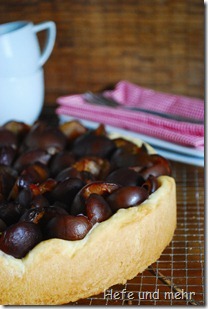 Last Sunday morning I wake up and heard the rolling thunder outside. Taking a look out of the window I decided that I would not leave the house to get some rolls from the bakery. The thunderstorm that was brewing outside turned the beginning day into night again. So I decided to spend the time in the kitchen preparing a dough for a plum cake instead.
Last Sunday morning I wake up and heard the rolling thunder outside. Taking a look out of the window I decided that I would not leave the house to get some rolls from the bakery. The thunderstorm that was brewing outside turned the beginning day into night again. So I decided to spend the time in the kitchen preparing a dough for a plum cake instead.
My boyfriend has a firm belief how plum cake has to be. The crumb should be airy and soft and thickly covered with plums. During baking the juice of the plums should soak the crumb. And he likes not streusel, no cinnamon or sugar on the plums. To be honest, I am not a great fans of plum cake at all. If I could choose between another cake and plum cake, I would take the other cake for sure. But of course I bake a plum cake if my boyfriend asked me to.
I choosed a mixture of yeast dough and short pastry as a cake base. This combined the advantage of both doughs: a fluffy dough that stays fresh for a long time and which keeps the plum juice in the dough. To prepare this yeasted shortcrust pastry is very easy: Just prepare a shortcrust pastry and yeasted dough and combine both doughs after the yeast dough has risen. That works very well and the handling of the dough is great.
The boyfriend liked the cake very much and even I can say that the cake tastes well!
Plum cake
Yeast dough
- 5g fresh yeast
- 65 g milk
- 55g Egg (1 Egg size L)
- 190g flour type 550
- 1 pinch Salt
- some citrus peel
- 1 Tsp Vanilla extract
- 20 g sugar
- 25g Butter
Shortcrust pastry
- 80g flour type 550
- 50g Butter
- 20g sugar
Topping
- 1200g Plums
Yeast dough: Dissolve yeast in milk and mix with egg, flour, salt and spices 5 min with hand. Now add half of the sugar, knead for 1 min, add the remaining sugar, knead again 1 min. Then add all of the butter and knead until well incooperated. Let rise for 1 hour.
Shortcrust pastry: Knead all ingredients until a crumbly dough has formed. Chill for 30 min.
Combine both dough and knead until a homogenous dough has formed. Roll to a circle and place it in a spring form with 26 cm diameter.
Remove the pit of the plums and place them upright in the spring form beginning at the rim of the cake.
Proof for 30 min then bake for 45 min at 180°C.
Deutsch



Pingback: Folge 19: Ein kurzes Intermezzo zwischen zwei Infekten – Frau Zwillingsnadel
Der war gut – muss ich mir merken 😁 ! Danke Dir !!
Liebe Grüße Sabine
@Sabine: Gell? 😉 Ich bin eben noch hier über verschiedene Sortenbeschreibungen gestolpert. Die Sorten Juna, Katinka und die Hauszwetschge Typ Schüfer sind wohl besonders gut geeignet zum Backen. Und hier gibt es noch Infos zu alten Sorten.
@Sabine: 😛 😀 😉
Hallo
Nein, kein Zucker aber: hatte Pflaumen statt Zwetschgen !! Das erklärt das Saftproblem ! Vielen Dank. Hättest Du eine Lösung?
LG Sabine
@Sabine: Zwetschgen verwenden 😉 Ansonsten würde ich es vielleicht mal mit einer Semmelbröselschicht zwischen Pflaume und Teig versuchen.
Liebe Stefanie,
alle Jahre wieder kommt der August mit leckeren Zwetschgen und ich gehe auf die Suche nach DEM Rezept für einen leckeren Zwetschgenkuchen. Ich muss gestehen, auch ich gehöre eher zu den Puristen, bin aber doch sehr neugierig auf Deine Variante!!
Darf ich fragen, warum Du 550iger anstelle des 405er Mehl benutzt?
Ein schönes Wochenende, liebe Grüsse Sabine
@Sabine: In diesem Fall habe ich aus Bequemlichkeit für den Mürbeteig auch 550er Mehl verwendet, da ich es eh für den Hefeteig brauchte. Bei Hefeteigen nehme ich immer (!) Type 550 oder höher, da 550er Mehl einen höheren Kleberanteil hat und der Teig damit fluffiger wird. Mehl Type 405 ist ein gutes Mehl für Rührkuchen und Mürbeteig, für Hefeteig aber aus Mangel an Klebeproteinen nicht so gut geeignet.
Vielen Dank für die schnelle Antwort, werde das Rezept heute ausprobieren!
Grüße, Sabine
Kurze Rückmeldung – wirklich toller Teig !! Vielen Dank !!
Noch eine letzte Frage – habe SEHR saftige Zwetschgen und dadurch jede Menge Saft auf den Früchten, der mir dann unter den Boden läuft, sobald der Kuchen angeschnitten wird. Sieht nicht nur nicht schön aus, sonder weicht mir den Boden von unten auf. Kennst Du das Problem auch? Wenn ja – gibt es da eine Abhilfe?
LG Sabine
@Sabine: Bestreust du die Zwetschgen direkt nach dem Backen mit Zucker? Wenn ja, würde ich es mal ohne Zucker probieren (bzw. auf dem Teller zuckern), das reduziert das Saften ungemein. Ansonsten hatte ich bei Zwetschgen dieses Problem bisher noch nicht, nur bei den runden Pflaumen.
Gestern habe ich ihn wieder einmal, aber mit viel Apfel und gehobelten Mandeln, gebacken. Meine Kolleginnen waren begeistert. 🙂
Immer wieder ein toller Kuchen!
Liebe Grüße Mama
Hallo Stefanie,
die ersten Stücke des Pflaumenkuchen sind gestern und heute verspeist worden. Der Teig hält was er verspricht. Auch am 2. Tag ist er nicht mal annähernd durchgesaftet, und ein prima handling beim auswellen bietet er auch noch. Ein schöner Teig auch für Backanfänger.
Für Papa werde ich aber die Zitronenschale aus dem Teig weglassen. Grüsse Mama
Ich versuchs mit Äpfeln , was für Zwetschgen passt ist auch gut für Äpfel. Und darin ertrinke ich zur Zeit !!! Klingt aber wie immer nach nem tollen Rezept , das sogar Diät haltende mItmenschen genießen können, Elke